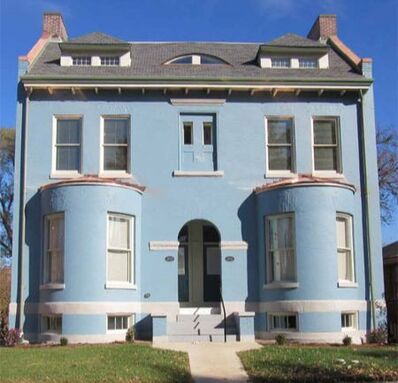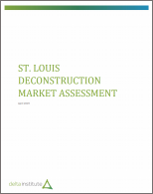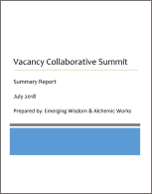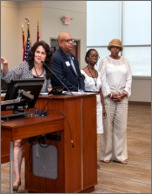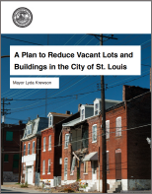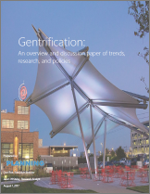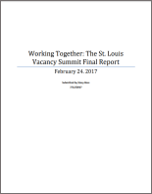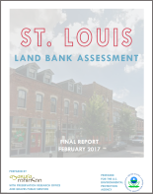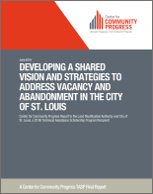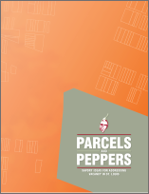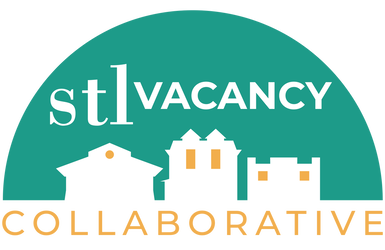|
The City of St. Louis has a serious vacant property challenge. Since the population peak in 1950, the City has experienced a 63% decline in population resulting in one of the highest rates of vacancy in the nation and totaling some 25,000 vacant properties.
These conditions represent a significant opportunity to not only invest in our future, but to also help break down inequities of the past and rebuild trust. We can create new forms of equitable development, improve the physical and mental health of people living near vacant properties, and encourage alternative land uses that create community assets. Below are documents which have fed directly and indirectly into the formation of the Vacancy Collaborative. While individually they contain different perspectives and areas of focus, together they constitute a vital reading list for understanding vacancy in St. Louis and undertaking systems-level change through positive solutions. For those interested, there's also a vacancy reading group that meets on the second Tuesday of each month from 4:00-5:30 at Gelateria Del Leone on South Grand Blvd. Contact Dana Malkus for more information. |
|
STL Deconstruction Market Assessment
Delta Institute April 2019; 39 pages Produced for the St.Louis Development Corporation and the Green City Coalition, this report assesses opportunities to leverage demolition and vacant structure removal programs and create positive economic and environmental outcomes for local residents and the region. |
|
Vacancy Launch Summary Report
July 2018; 22 pages Report on the half-day Vacancy Collaborative Launch/Summit, a meeting of Nearly 170 individuals, representing community members and attendees from the academic, banking, business, community, non-profit and government sectors. The report summarizes the results of the breakout sessions to identify key issues within each of the six top-level working groups with prioritization, supporting rationale, and likely or potential stakeholders. |
|
Vacancy Collaborative Launch Presentation
July 2018; 47 slides Overview of vacancy in St . Louis, along with a summary of action taken by the steering committee, overview of the working group structure, and introduction to the Vacant Property Portal. |
|
Former Mayor Krewson’s Vacancy Plan
July 2018; webpage Outline of initiatives including data-driven decision making, reducing LRA inventory, increasing code enforcement, more funding for demolitions, and developing alternative stabilization practices. |
|
City of St. Louis Planning and Urban Design Agency's Gentrification Report
August 2017; 31 pages An overview and discussion paper of trends, research, and policies related to gentrification in St. Louis City. |
|
Vacancy Summit Report
Stacy Ross, 2017; 21 pages Overview of one of the first formal meetings between neighborhood residents, nonprofit leaders, and city government to address vacancy. |
|
Land Bank Assessment
Asakura Robinson Company February 2017; 34 pages The results and recommendations from an assessment of the Land Reutilization Authority (LRA)'s land bank operations. The study was paid for by the U.S. Environmental Protection Agency as part of the City's involvement in Strong Cities, Strong Communities. |
|
Center for Community Progress Report
June 2016; 30 pages A report to the Land Reutilization Authority for developing a shared vision and strategies to address vacancy and abandonment in the city of St. Louis. |
|
Parcels and Peppers: Savory Ideas for Addressing Vacancy in St. Louis
Kansas State University Community Planning and Design Studio 2015; 299 pages This book presents planning and design strategies for understanding vacancy conditions, a range of ideas for repurposing vacant property, and a variety of methods for engaging people in a planning and design dialogue about vacancy. Throughout the book the authors use a metaphor of “spiciness” to communicate a gradient of ideas, inspired by the chili pepper shape of St. Louis’ city boundary. |
